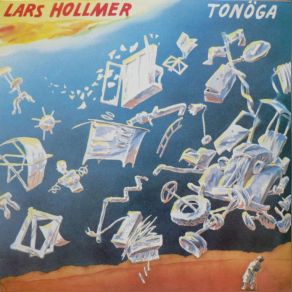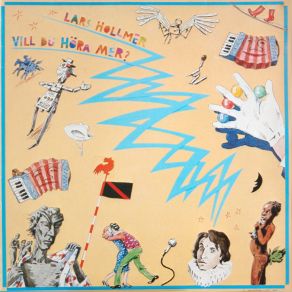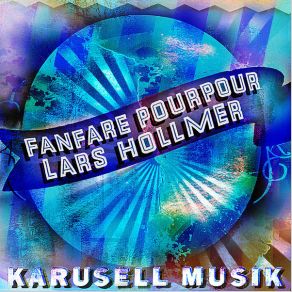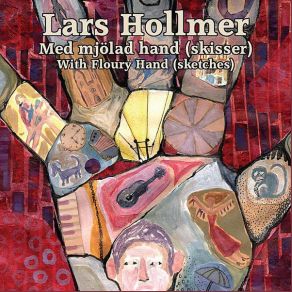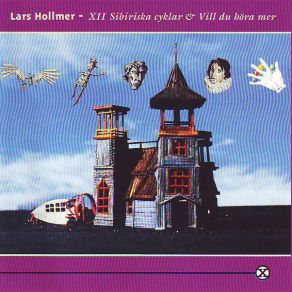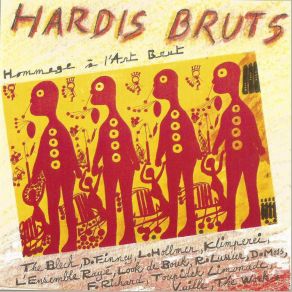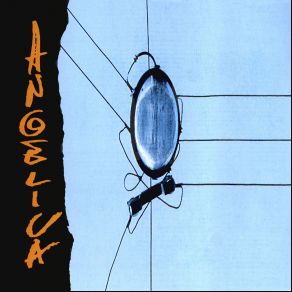Lars Hollmer
Wikimp3 information about the music of Lars Hollmer. On our website we have 12 albums and 4 collections of artist Lars Hollmer. You can find useful information and download songs of this artist. We also know that Lars Hollmer represents Rock genres.
Biography
[Edit]Swedish composer, accordionist, and keyboardist Lars Hollmer was a much beloved artist who escaped the notice of many during his lifetime but who nevertheless touched listeners across the world from Europe to Asia to North America. Given his longstanding membership in the quirky Samla Mammas Manna, he was often considered a progressive rock performer, but Hollmer could just as easily be placed in folk, avant-garde, world, or even classical categories. Upon hearing his music, however, it's also easy to understand how he rendered labels meaningless, since his many influences were united by such a singular artistic persona. Rather than define Hollmer's music via stylistic boxes, it is perhaps best to focus on its warmth, intimacy, and even innocence, and its occasional tinges of melancholy. And while some of his compositions may be a bit demented at times, with unconventional instrumentation and odd time signatures, his music is also tuneful and accessible, and often disarmingly lovely.
Most of Lars Hollmer's recorded music was made at the Chickenhouse, a recording studio at his home outside of Uppsala, Sweden. This is where the first incarnation of Samla Mammas Manna assembled in 1969-1970 to record the band's initial, eponymous album, released in 1971. At that point the band featured Hollmer on keyboards (although his first instrument as a child had actually been a zither — which he soon modified into a "prepared zither" — given to him as a gift by his grandmother) along with bassist Lars Krantz, drummer Hans Bruniusson, and percussionist Bebben Öberg. Guitarist Coste Apetrea would join the Samlas in 1972, and the quartet of Hollmer, Bruniusson, Krantz, and Apetrea would release Måltid the following year. Throughout the 1970s, Hollmer was best known for his work under the Samlas umbrella, including the albums Klossa Knapitatet in 1974 and Snorungarnas Symfoni — a record actually written by American composer Gregory Fitzpatrick but performed by Samla Mammas Manna — in 1976. Hollmer also joined a folk- and world music-oriented quintet, Ramlösa Kvällar, in the late '70s; the band also included Apetrea from the Samlas along with saxophonist Ulf Wallander, trumpeter Kalle Ericksson, and percussionist Bill Öhrström, and released the album Nights Without Frames in 1978. Notably, it was with Ramlösa Kvällar that Hollmer reportedly first began playing the accordion.
In the various Samlas groupings, Hollmer was featured in a prominent role as co-composer and fusion-oriented electric keyboardist (perhaps with a somewhat Canterbury flavor), but not "leader" per se. The band's music mixed prog and jazz-rock elements with stylistic wild cards ranging from wacky nonsense vocals to atmospheric free improvisation, an adventurous enough combination for the group — after briefly disbanding and re-forming under the altered moniker Zamla Mammaz Manna with guitarist Eino Haapala as a replacement for the temporarily departing Apetrea — to join an aggregation of European avant-prog bands including Henry Cow, Univers Zero, and Etron Fou Leloublan under the Rock in Opposition umbrella. During this period, the newly christened Zamlas released the double-LP set Schlagerns Mystik/För Äldre Nybegynnare (1978), featuring a disc of folk and prog-style "songs" and a disc of improvisations that garnered particularly strong critical accolades from Henry Cow drummer Chris Cutler.
Given that Samla/Zamla LPs (on the Silence label) were mainly available in the United States through specialized mail-order outfits like Wayside Music, still a good source for Hollmer recordings), most stateside listeners first heard Hollmer and other Samla/Zamlas members through their involvement in Fred Frith's Gravity album (released in the States on Ralph Records), half of which was recorded at the Chickenhouse in August 1979. The album mixed the Henry Cow guitarist's skewed sonic explorations with a distinct European folk dance feel, to which Hollmer and company were important contributors. From March to June 1980, the Zamlas recorded and released Familjesprickor (aka Family Cracks), which was according to the liner notes "made during a period of transition," leading to music "which is not as optimistic and happy as it used to be." As it turned out, this would be the last Zamlas appearance on record until Kaka was released in 1998 (the band re-formed in the early '90s but it took until 1998 for the evidence to turn up on disc). In the early '80s Hollmer would turn his attention elsewhere — including his own solo efforts that would continue through the next two decades and beyond.
With the cracks in the Zamla family once again leading to the group's dissolution, Hollmer and Haapala joined with Denis Brely and Jan Garret, two members of eccentric French avant-popster Albert Marcoeur's band, to form the Von Zamla quartet and continue waving the flag of folk-flavored instrumental experimental and avant-prog rock (with perhaps a bit of fusion and neo-classicism thrown into the mix for variety's sake). In 1982 the first Von Zamla album, Zamlaranamma, was released, and the group soon transmogrified into a sextet no longer including Brely and Garret but notably featuring Univers Zero bassoonist/oboist Michel Berckmans and Munju bassist Wolfgang Salomon; this band toured Europe and recorded No Make Up! at the Chickenhouse in May and August 1983. As of the late 2000s, the most widely distributed document of Von Zamla is the live CD entitled 1983, recorded live in Bremen and released by Cuneiform in 1999. As Hollmer wrote in his enthusiastic liner notes, the band toured by bus and played a huge array of instruments, including various keyboards, guitar, bass, accordion, melodica, drums, glockenspiel, bassoon, oboe, English horn, and ring modulator, not to mention such percussive devices as "homemade plate," "metal pin-filled cans," and "bottles of different kinds."
And although he noted that Von Zamla "had TREMENDOUS FUN!!," Hollmer was at this time beginning to truly assert himself through his solo efforts apart from the band, beginning with 1981's XII Sibiriska Cyklar, which he had recorded entirely solo at the Chickenhouse in June and October of 1980 and March of 1981. (Von Zamla broke up in fall of 1984, briefly re-forming with an altered lineup in 1985 before splitting up for good.) Included on XII Sibiriska Cyklar is a two-and-a-half-minute tune of simple beauty and charm that will likely forever stand as one of Lars' most famous and beloved pieces, "Boeves Psalm," an homage to his deceased uncle Edvard. Fellow accordionist, friend, and musical collaborator Guy Klucevsek has described "Boeves Psalm" as "one of the most beautiful melodies ever written," and AMG reviewer "Blue" Gene Tyranny has noted that the "delightful song" features a "deceptive cadence with a Mozart feel."
XII Sibiriska Cyklar was followed in 1982 by Vill du Hora Mer, the first release on Hollmer's KRAX label, and then came Från Natt Idag in 1983 and Tonöga in 1985. Hollmer sang and played nearly all the instruments on these albums (all recorded at the Chickenhouse), which ranged from warm and intimate folk-flavored songs to wild yet tuneful and focused instrumental compositions. On these and indeed all the solo albums throughout his career, Hollmer would feature himself on keyboards and accordion, but would also experiment with a host of additional embellishments, from playing glockenspiel, bells, and oddball percussion to blowing into glass bottles, recording the sound of boot steps crunching on snow, and even using the "vocals" of his own infant children and, later, grandchildren on a lullaby or song celebrating the arrival of new life. But such sonic experimentation was always integral to the feeling and mood of a tune, not the exploration of mere isolated sounds and noises for their own sake, devoid of a human-centered context.
The year 1985 was an important one for Hollmer, marking the formation of his first group as a leader, the Looping Home Orchestra. The LHO toured Europe in 1986 and 1987, during those years also recording the fifth KRAX-label album, Vendeltid, at the Chickenhouse with a five-man lineup. Vendeltid was a high watermark for Hollmer, retaining all the charm, melodiousness, and inventive rhythms of his earlier solo efforts (not to mention his work with the Samlas) with music of sometimes haunting and ethereal beauty, with tones somewhere between the lightness of Penguin Cafe Orchestra and the darkness of Univers Zero.
Selections from the five solo Hollmer releases of the 1980s, including Vendeltid, were later compiled onto the 1993 single-CD set entitled Lars Hollmer 80-88 (later reissued as The Siberian Circus), and well illustrate his artistic growth during the decade. In the disc's liners, Fred Frith noted the futility of assigning stylistic descriptors to Hollmer, indicating that, like all great composers, Hollmer's work touches the listener at a deeper level. "Like Astor Piazzolla, Lars Hollmer is a serious composer working in a popular traditional language and one who defines his own terms," Frith wrote. "Sometimes Lasse's manic skittishness and infectious enthusiasm give way to the most eloquent expression of our inherent loneliness that I know of," Frith continued. "This is no small gift."
In Hollmer's compositions of this time one may hear the echo of classical works of a magical mood — Saint-Saëns' Aquarium from Le Carnaval des Animaux for example — but with a rustic quality entirely absent from the concert hall, as if the (in his case Hungarian) folk themes Bartók discovered and used in his compositions had been wrested away from the classical setting and returned to their earthier points of origin, while also somehow maintaining a contemporary feel. (It is perhaps worth noting here that Hollmer was a self-taught musician.) And yet his music was not merely a facile appropriation of folk themes to rock music in the manner that proggers "rocked the classics" — his music maintained an authenticity, originality, and depth of feeling that the far more prosaic rock bands rarely even hinted at.
It was also during this period that Hollmer began composing music for various film, theater, and dance projects, including collaborations with former Von Zamla bassist Wolfgang Salomon. Two Hollmer/Salomon projects were released on Salomon's Chance Records label, 1989's Alice im Wunderland, from a theater production based on the Lewis Carroll novel, and 1996's Neunerplatzmusik No. 3, the latter a trio release by Salomon, Hollmer, and Thomas Heinemann of the Theater am Neunerplatz in Wurzberg, Germany (and issued as a Chance/KRAX co-production). From the late '80s into the '90s Hollmer was also a member of another progressive world/folk quartet, Fem Söker En Skatt, somewhat in the mold of Ramlösa Kvällar and indeed also featuring saxophonist Ulf Wallander and trumpeter Kalle Eriksson from that earlier ensemble.
In 1988 the original Looping Home Orchestra played their last concert, but new incarnations of the group would follow, and Hollmer would continue to pen new compositions for the ensemble. In 1992 the fourth version of the group consisted of Hollmer, Haapala, Krantz, and Frith along with Fem Söker En Skatt keyboardist/percussionist Olle Sundin and Montreal multi-instrumentalist Jean Derome; this band performed at the 1992 Festival International de Musique Actuelle de Victoriaville in Quebec and then toured Europe in 1993; selections recorded at FIMAV and on the European tour were released on Door Floor Something Window: Live 1992-1993 on the Victo label in 1994. In many ways, the recording represented a culmination of Hollmer's work as a solo artist to date, with dynamic and fiery live performances and off-kilter sonic touches wedded inseparably to the composer's evocative melodies and overarching compositional sense.
In 1993 he began recording his solo works at a revamped Chickenhouse (the original studio had been torn down in 1992 and Hollmer, a skilled carpenter, built the new one mainly himself), including eight tracks of the 26-track Vandelmässa odds 'n' ends collection gathering music composed and recorded across the preceding decade but not included on his other albums to date — and there would be far more to come. In 1996 Hollmer would be the first musician chosen by the aforementioned Klucevsek to join him in Accordion Tribe, an international quintet of accordionists also featuring Maria Kalaniemi from Finland, Bratko Bibic from Slovenia, and Otto Lechner from Austria; the group would concertize widely in Europe and Canada, release three acclaimed CDs, and be the subject of a feature-length film. And in 1997 Hollmer would finish recording a new solo CD entitled Andetag, which was released the following year.
Featuring music composed between 1993 and 1996, Andetag was yet another peak for Hollmer, paradoxically comfortable and challenging, traditional and cutting-edge, with all of the diverse stylistic touchstones one had come to expect from a Lars Hollmer album. Again, most of the instruments were played by Hollmer (accordion, piano, keyboards, melodicas, and percussion) along with contributions from bassist Wolfgang Salomon, violinist Santiago Jimenez, drummer Hans Bruniusson, and bassoonist/oboist Michel Berckmans. In 1999 Andetag won a Swedish Grammy Award, and as part of the award Hollmer was cited as follows: "To a giant in the Swedish musical society...from Samla Mammas Manna to 'Boeves Psalm' to the new CD Andetag...there's always wonderful music coming from the Chickenhouse."
Hollmer also began a new project in 1999, assembling many of the same musicians as had appeared on Andetag along with Coste Apetrea (on banjo), Matti Andersson (on flute), and Kalle Eriksson (on trumpet) for the recording of the neo-classical chamber music-influenced Utsikter, released in 2000 and a worthy follow-up to Andetag. The Utsikter project also involved a touring ensemble including Salomon, Jimenez, Berckmans, and Andersson — this group made festival and concert appearances in Russia, Serbia, and Sweden in 2000 and 2001.
Meanwhile, the on-again, off-again Samlas had been beckoning, and in fall of 1998 Hollmer, Krantz, Bruniusson, and Apetrea were back together at the Chickenhouse for the recording of Kaka, a sometimes powerful, sometimes zany recording including live concert material from 1993-1998 and voice-over "comments and interpretations" for the uninitiated by a "narrator" named John Fiske. The album was released in 1999, but in November of that year Bruniusson, who had been with the Samlas from the very beginning 30 years previously, quit the band. As it turned out, Samla Mammas Manna would carry on after some communications between Uppsala and a perhaps surprising location, Japan. In 2000 Hollmer received an invitation from clarinetist Wataru Ohkuma and Ruins drummer Tatsuya Yoshida to perform with them in Tokyo, and off he went.
The trip to Japan marked yet another turn in Lars Hollmer's musical journey, as he joined with Ohkuma, Yoshida, and others (notably violinist Yuriko Mukoujima) to form a new band entitled SOLA. In December 2000 Hollmer performed a number of concerts at Tokyo venue Mandala-2 with this ensemble, and was impressed enough by the experience to return to Japan during summer and fall of the following year for more concertizing and the recording of a CD, which was released in 2002 with the title SOLA: Lars Hollmer's Global Home Project. And with drummer Bruniusson gone from Samla Mammas Manna, Yoshida agreed to join the now legendary avant-prog quartet as his replacement, bringing an incisive and crazed Ruins touch to the Samlas' sound.
The Swedish/Japanese Samlas can be heard on the 14th KRAX label release, Dear Mamma, recorded live (from a single DAT recorder in the audience, from the sound of it) in Uppsala on May 16, 2002. The disc is particularly notable for including a lengthy track recorded in 2001 at another Uppsala venue — featuring the quartet of Hollmer, Apetrea, and Ruins' Yoshida and Hisashi Sasaki, "Fredmans Session 2" is more improvisational in nature than most of the Samlas' recorded output, yet remains dynamic and focused, with a high energy level and a sense of purpose that never wanders. (In 2007 a Bonus Tracks edition of Dear Mamma was released that eliminated "Fredmans Session 1" and "Fredmans Session 2," replacing them with eight shorter tracks recorded live at Fab and La Mama in Tokyo during September 2002.) Keeping the SOLA connection alive, Hollmer returned to Japan in the spring of 2003 to perform and record in duet with violinist Mukoujima; some of the results of this pairing can be heard on the mini-CD Live and More, the 15th KRAX release.
And after performing with the Looping Home Orchestra and with Accordion Tribe in Victoriaville, Hollmer maintained his Quebec connections, in August and September of 2004 visiting Quebec once again, making an accordion festival appearance in a trio with Jean Derome and drummer Pierre Tanguay, and also performing twice at an intimate auberge near the tiny Quebec village of St. Fortunat, once with Derome and Tanguay and once with the threesome supplemented by La Fanfare Pourpour, a 19-piece wild circusy big band with a street carnival sensibility and friendly, homespun charm. Hollmer performed in duet with Michel Berckmans at the April 2005 Gouveia Art Rock Festival in Portugal, and both Hollmer and Berckmans joined Montreal avant-prog mainstays Miriodor on-stage at the festival as well. Hollmer also contributed accordion to Miriodor's Parade, released on Cuneiform in May 2005; he recorded his parts in Sweden and added them to Miriodor's compositions through an approach unthinkable when the Chickenhouse resident first picked up a squeezebox — sending work-in-progress music files back and forth across the Atlantic on CD-Rs.
Hollmer returned to the Festival International de Musique Actuelle de Victoriaville in May 2005 for another Quebec performance with La Fanfare Pourpour, an upbeat and rollicking yet warm and emotionally engaging concert of music penned by Hollmer and orchestrated by Derome, including some new compositions with at least a slight tip of the hat to FIMAV's avant-garde attitude. In October 2006 Hollmer was back in Quebec to record Karusell Musik with the Fanfare Pourpour, and the album was released as a joint project of the KRAX and Monsieur Fauteux M'Entendez-Vous? labels during spring of the following year. September 2007 marked yet another trip to Quebec, as Samla Mammas Manna performed at Le Festival des Musiques Progressives de Montreal and Hollmer — appearing barefoot on-stage as was his custom — accompanied Miriodor in playing a piece from Parade. The following spring (March 2008), Hollmer could be spotted on-stage during the Melloboat seafaring prog rock and metal festival organized by the Mellotronen label; the two-day festival took place aboard the Silja Symphony luxury ferry, cruising the Baltic Sea between Stockholm and Helsinki. Lars performed with the Mats/Morgan All Star Team, in a set that included a rollicking version of "Nationsjazz" and had the audience clapping along to "Boeves Psalm."
In November 2007 a new Hollmer solo album, Viandra, had been issued in Japan by the Disk Union label; a U.S. release on Cuneiform followed in May of 2008. A somewhat reflective and at times even melancholic album — although certainly leavened by the expected moments of happiness and exuberance — Viandra was recorded between 2001 and 2007 at the Chickenhouse, with Hollmer multi-tracking himself on a variety of instruments (and also creating the cover photo collage). Various longstanding collaborators also participated, notably Michel Berckmans, Santiago Jimenez, and (on one track) Ulf Wallander. Almost astonishingly given Hollmer's nearly 40-year recording career, the Cuneiform edition of Viandra was his first U.S. album release as a solo artist. As it would turn out, Viandra was also the last solo album Lars would see issued during his lifetime.
Lars Hollmer was an artist who looked back at the past with fondness and warmly embraced his many experiences with family, friends, and musical collaborators around the world, but he always seemed to be looking toward the future as well. So it was a shock to all who knew him when he became gravely ill during 2008 and, diagnosed with cancer, was unable to participate in planned European tours of Accordion Tribe (Amy Denio appeared in his stead) and Fanfare Pourpour, the latter ensemble focusing entirely on Lars' repertoire during an October ten-concert tour in France and Sweden. During the final show of the tour, however, at a packed venue in his hometown of Uppsala, Lars was able to summon up the spirit and energy to join Fanfare Pourpour on-stage for a complete performance of his compositions from the joint Hollmer/Fanfare album Karusell Musik. The performance was filled with many favorite compositions from Hollmer's previous quarter-century as a solo artist and bandleader, and he reportedly seemed quite happy as the audience delivered multiple ovations in response to the playing of his classic tunes, including "Boeves Psalm." It would be Lars Hollmer's last appearance on-stage. On Christmas of 2008, Lars succumbed in his battle with cancer. He was 60 years old.
Soon after Lars' death, Guy Klucevsek reflected upon his Accordion Tribe friend: "He could be unabashedly sentimental ('Boeves Psalm,' 'Soon Song'), write incredibly dense and complex counterpoint with the best of them ('Pas de Valse,' 'Utflykt Med Damcykel'), and be mischievous and joyfully whacked-out ('Cirkus I,' 'Cirkus II')." Noting Hollmer's varied and extensive discography as both leader and collaborator, Klucevsek found Lars' own words and gestures to be the best summation of his music's "common element": "To quote Lars from the documentary film Accordion Tribe: Music Travels (Stefan Schwietert, Maximage Films, 2004), 'It all begins here' (he says, pointing to his heart); 'it may go through here eventually' (he points to his head), 'but it all begins with the heart.'"
As the last Lars Hollmer CD released during his lifetime — and particularly given its sometimes elegiac mood (and even the cover collage that depicted so many elements of his musical and family life) — a few listeners might have concluded that, at some level, Lars intended Viandra to be a final musical statement. But that was actually far from the truth. Even before Viandra's release, Lars had been thinking of his next album, and intended it to be in marked contrast to Viandra's melancholia. He had begun assembling material that would reflect his crazy side, and a title was chosen: Med Mjölad Hand (With Floury Hand). He even asked his son Gabriel Strand Hollmer to listen to some of this material and provide input about tracks to include in Med Mjölad Hand — however, after Viandra was issued, Lars' decline in health made it impossible to continue with his plans for the album.
After Lars' passing, Gabriel needed some time away from his father's music, but in fall 2009 he began delving into the Chickenhouse archive, listening to the Med Mjölad Hand material as part of the grieving process and also to honor his father's request for help in shaping the project. It became clear to Gabriel that the archive held much music worthy of a wider hearing, and with encouragement from Steve Feigenbaum at Cuneiform, he began assembling a diverse selection of tracks that extended as far back as the early to mid-'80s. Ultimately, 26 tracks in various stages of completion were chosen, some of which reflected the flavor of craziness Lars had originally intended for Med Mjölad Hand, while others (including Chickenhouse-recorded versions of tunes that had appeared in altered form on other Hollmer releases) touched on different moods and emotions characteristic of his music over the years, from light and whimsical to ethereal and beautiful to dark and unsettling.
Meanwhile, Feigenbaum and Cuneiform secured the rights to release on DVD a professionally shot, multi-camera video of Hollmer's aforementioned 2005 Gouveia Art Rock Festival performance, primarily solo but also in duo with bassoonist Michel Berckmans and together with Miriodor. The DVD (also featuring a 2005 duo performance of Lars with accordionist Fizzè at a small venue in Switzerland) was included as a second disc accompanying the Med Mjölad Hand CD compiled by Gabriel (and mastered by Cult of Luna's Magnus Lindberg), with the two-disc CD/DVD set ultimately released by Cuneiform in May 2012. Since much of the music on the CD had not been finished by Lars and was in various stages of completion, the title of the collection was appended with a parenthetical "(skisser)" — i.e., "(sketches)." The CD/DVD's cover artwork was painted by Lars' daughter and Gabriel's sister Rinda Strand Hollmer.
Title: Vill du höra mer? / Vill du hora mer?
Artist: Lars Hollmer
Genre: Rock, Progressive Rock, Punk Rock, World Music, Classical
Title: Från Natt Idag / Fran Natt Idag
Artist: Lars Hollmer
Genre: Rock, Progressive Rock, Punk Rock, World Music
Title: Vendeltid
Artist: Lars Hollmer
Genre: New Age, Rock, Progressive Rock, Punk Rock, World Music, Classical
Title: Neunerplatzmusik No. 3
Artist: Lars Hollmer, Wolfgang Salomon
Genre: Kids, Theatre/Soundtrack
Collections
Title: Rough Guide to Scandinavia
Genre: World Music
Title: Angelica 92
Genre: Jazz, Contemporary Jazz
Title: Planet Squeezebox
Genre: Hip Hop/R&B, Jazz, Cool Jazz, Ranchera, Samba, Tango, World Music, Latin, Contemporary Folk, Bop
